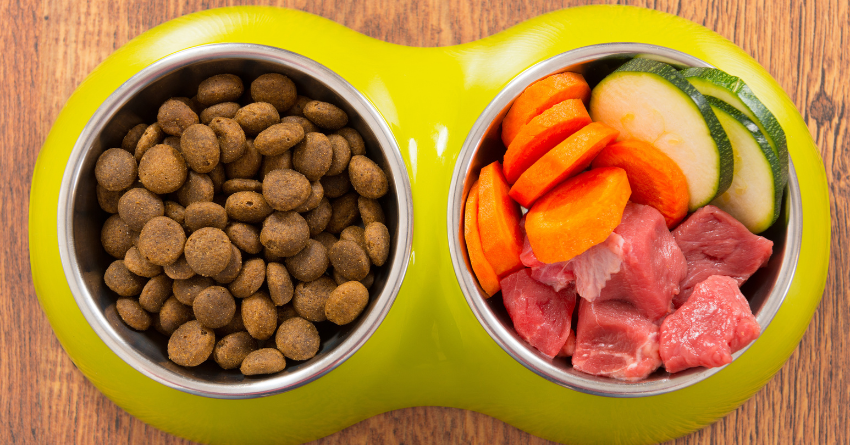Since 2021, fresh dog food has gained popularity, with fresh pet food sales increasing by 86%. Many consider fresh dog food to be more nutritious than dry dog food — but dry dog food can be as healthy, and well-suited for a dog’s diet!
There are two types of dry dog food: traditional dry kibble and dehydrated dog food. While most pet owners are familiar with kibble, dehydrated food is made with the same fresh ingredients as fresh food, but it’s gently dehydrated to a dry state that you rehydrate just before serving.
But there’s more to the fresh versus dry debate. Below, we’ll take a deeper dive into the differences to help you make an informed choice about what to feed your pup.
Important Differences Between Fresh Dog Food vs. Dry Dog Food
Many pet owners imagine that fresh dog food must be healthier and more nutritious for their dogs than dry dog food — particularly kibble — due to less processing. But the truth is that kibble can offer similar nutrients to fresh food with more convenience and better costs.
When comparing fresh dog food with dry dog food options, including kibble or dehydrated dog food, you’ll see that the answer isn’t as clear-cut as you once thought. Let’s take a closer look at some of the key differences to help you make an informed decision for your furry friend.
Nutritional Content
Fresh dog food is often seen as the healthier option, mostly due to its high moisture content, which supports a pup’s hydration and aids in digestion. Fresh diets are considered 40% more digestible, more bioavailable and less calorically dense.
On the other hand, traditional kibble is dense in calories and may be less digestible due to its lower moisture content.
Dehydrated dry dog food falls in between fresh and kibble. On one hand, it’s more gently processed and contains fewer artificial preservatives than kibble. It’s also more convenient and space-efficient than fresh food. On the other hand, it takes longer to prepare than kibble, and may not be as visually appetizing as fresh food.
However, it’s much more nutritionally dense than both kibble and fresh food. This shows that you need less dehydrated food to get the same nutritional value as kibble or fresh food.
Overall, dehydrated dog food offers a balanced middle ground. To that end, high-quality dry dog food can still deliver well-rounded nutrition, especially when it's made with premium, minimally processed ingredients — whether it’s dry or dehydrated.
Cost and Value
Fresh dog food typically comes with a higher price tag compared to kibble, as it uses fresher ingredients and often requires careful storage and refrigeration. The cost of providing fresh meals for your pup can quickly add up, especially for large breeds or active dogs with higher caloric needs.
In contrast, dry kibble dog food can be more budget-friendly and available in bulk, making it a cost-effective option for many dog owners. Dehydrated dog food sits in the middle again when it comes to cost, as it’s usually a higher price point than kibble but less expensive than fresh.
Convenience
As far as sheer convenience, dry dog food has a clear advantage. Kibble and dehydrated food requires no refrigeration, has a long shelf life and is easy to store. Dehydrated dog food has another advantage because, before you add water, it takes up minimal space, unlike large bags of kibble. This makes dry dog food a practical choice for busy pet parents with limited storage space.
Fresh dog food isn’t as convenient. It requires refrigeration and has a shorter shelf life, meaning you can only purchase small amounts at a time (so you’ll make more frequent trips to the store).
Convenience is subjective, and what works well for your lifestyle may not be what works for the next dog owner. Consider your (and your dog’s) lifestyle to best determine whether fresh or dry food may be more convenient.
Ease of Feeding
Dinner time with dry food is as simple as scooping kibble into your dog’s bowl. It’s convenient for portion control and can be left out longer without risk of spoilage.
In contrast, fresh food requires more effort to feed (refrigeration and preparation), and it can’t be left out as long due to risk of spoilage. Though many dogs love fresh food for its aroma and texture, it isn’t as easy when feeding time comes. Once again, the middle ground is dehydrated dog food, which can be stored conveniently and travels well. Simply mix it with water or bone broth and wait three minutes before serving!
Comparing Different Dog Food Options at a Glance
To get a clearer picture of the difference between the types of dog food, refer to the chart below that outlines how the following stack up against one another: fresh dog food, dry traditional kibble, dry dehydrated dog food and dry whole food clusters exclusively from The Honest Kitchen.
Factor |
Fresh Dog Food |
DRY - Traditional Kibble |
DRY - Dehydrated Dog Food |
DRY - Whole Food Clusters |
Human grade |
Yes |
No |
Yes |
Yes |
Nutrition |
Real, whole ingredients |
Typically uses meals and artificial preservatives |
Real, whole ingredients |
Real, whole ingredients |
Cost |
$$$$ |
$ |
$$ |
$ |
Convenience |
Must stay cold in freezer or fridge, required defrosting if frozen |
Shelf-stable, simply scoop and serve |
Shelf-stable, simply add warm water to serve |
Shelf-stable, simply scoop and serve |
Processing |
Very limited processing |
Highly processed |
Minimally processed |
Minimally processed |
Moisture (for digestion) |
Highly moist |
Low/no moisture |
Highly moist |
Medium moisture |
As the table shows, while fresh dog food has clear benefits, other forms of dog food like The Honest Kitchen’s dehydrated and dry food clusters are comparable — or even better in some cases.
It’s important to keep in mind that not all dry dog food brands are equal; some are made with higher quality ingredients than others. Incidentally, The Honest Kitchen’s dry food options offer convenience and the added benefit of minimally processed, human grade ingredients.
Is Fresh Dog Food Really the Better Option?
It’s clear that fresh dog food has become something many dog owners have considered in recent years. Whole, minimally processed ingredients that are closer to a dog’s natural diet can sound appealing. However, “fresh” doesn’t automatically mean “better” for every dog.
Fresh food certainly offers several benefits, as it’s highly nutritious with fewer ingredients and preservatives, which can lead to smaller stools. However, it also comes with challenges related to spoilage, storage and ease of feeding.
A key difference between fresh food and dry food is that fresh food has a wetter texture than dry dog food. Accordingly, dental health is a major consideration. Fresh dog food may be gentler for pups with sensitive gums, gum disease or other dental problems.
Additionally, advancements in pet food manufacturing mean high-quality dry and dehydrated dog foods offer many of the same benefits as fresh dog food at a lower cost. Dehydrated options strike a balance between nutrition and convenience, offering minimal processing but long shelf life. Some top-tier kibble brands are also using better ingredients and nutrient-dense recipes that can compete with fresh dog foods without the risk of spoilage.
If you’re unsure which type of food is right for your pet’s diet , start by looking at the ingredient list of the different dog foods. Then, schedule an appointment with your veterinarian or veterinary nutritionist who can offer more specific guidance based on your pet’s life stage, medical history and specific nutritional requirements.
The Honest Kitchen’s Approach to Dog Food Nutrition and Selection
As noted, The Honest Kitchen uniquely approaches dog food nutrition by prioritizing whole-food ingredients, convenience and transparency. The Honest Kitchen’s philosophy centers on the belief that every pet deserves the same high food standards as humans. Let’s explore some of The Honest Kitchen’s standout offerings across different dry food recipes.
Whole Food Clusters
Whole Food Clusters from The Honest Kitchen are made using human grade ingredients. They’re prepared in a gentle, slow cooking process that preserves the nutritional integrity of each ingredient, mimicking a whole-food diet. The clusters offer the ease of dog kibble with the quality of fresh, whole foods, making them a balanced choice for pet owners.
Some standout recipes of Whole Food Clusters include:
Grain-Free Chicken Whole Food Clusters: This grain-free recipe is made with cage-free chicken, potatoes, peas, broccoli, pumpkin and apples to support lean muscles and overall health benefits.
Whole Grain Beef Whole Food Clusters: Using ranch-raised beef and organic grains, this recipe offers a hearty, balanced diet for dogs that thrive on barley, oats and carrots.
Whole Grain Chicken Whole Food Clusters: This balanced recipe made with free-range chicken and organic grains is perfect for dogs who do well with grains in their diet and require lean protein sources.
Explore more whole food cluster recipes from The Honest Kitchen.
Dehydrated Dog Food
The Honest Kitchen’s Dehydrated Dog Food blends fresh nutrition with the convenience of dry food. With just a little water or broth added, these meals transform into a nutritious homemade-style dish. This line is known for its nutrient-dense recipes, offering more bioavailable nutrients pound for pound than traditional kibble.
Here are a few popular dehydrated varieties:
Grain-Free Beef Recipe: Packed with ranch raised beef, sweet potatoes, flaxseed, papayas and pumpkins, this dehydrated food is high in protein and easy to digest.
Whole Grain Chicken Recipe: With a hearty mix of free-range chicken, organic oats and healthy produce like celery, bananas and carrots, this recipe is ideal for dogs who need sustained energy from healthy carbohydrates.
Limited Ingredient Fish Recipe: Dogs with allergies, dietary restrictions, or sensitivities will love this recipe full of white fish, pumpkins and coconut.
Continue exploring The Honest Kitchen’s dehydrated dog food.
Wet Dog Food
For the picky eaters, Wet Dog Food from The Honest Kitchen may be worth exploring. Made with human grade ingredients and no fillers, by-products or artificial additives, these meals offer the nutritional benefits of a fresh food diet with easier storage and feeding.
Here are a few flavorful recipes to consider:
Butcher Block Pâté - Beef and Cheddar & Veggies: This protein-packed pâté features ranch raised beef and wholesome veggies like carrots, green beans and broccoli.
One Pot Stew - Chicken & Super Greens: This savory stew is made with free range chicken and packed with nutritious greens and fiber-rich ingredients like spinach, sweet potatoes and apples.
Butcher Block Pâté - Turkey & Autumn Veggies: For a satisfying stew option, this recipe combines humanely raised turkey with seasonal veggies for a comforting meal.
Make the Right Choice for Your Pup With The Honest Kitchen
There are several dog food options available, ranging from something you pull off the shelf to put in a dog bowl to something you prepare yourself from scratch ingredients.
Fresh dog food can be an enticing, nutrient-dense, hydration-rich option, but it also has drawbacks, like a short shelf life and the need to refrigerate. With dry and dehydrated options, you get the convenience of kibble with holistic nourishment that’s similar to fresh food.
The Honest Kitchen’s dry, dehydrated, and wet food options offer an excellent alternative to fresh dog food. They’re affordable choices that don’t sacrifice quality, nutrition or taste!
Explore The Honest Kitchen’s complete line of dog food options — including supplements, treats and toppers!




